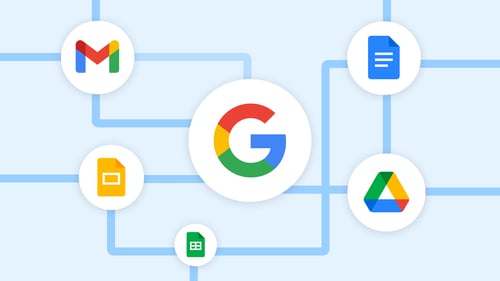What you need to know about eDiscovery with Google Workspace

Let's face it: Enterprise data is growing in size, diversity, and dynamism at such a rate that working against this new paradigm, rather than with it, simply won't be effective. Instead, a rising number of companies are opting for a forward-thinking, proactive eDiscovery approach, pivoting toward 'moving left' on the Electronic Discovery Reference Model (EDRM). This strategic shift involves conducting early case assessments directly at the source — a vital step that can expedite timelines, mitigate risk, and control costs.
Enter Google Workspace, the cloud-based platform packed with a vast range of applications to meet your business needs. But there's a catch: its built-in eDiscovery tool, Google Vault, has certain limitations that could trip up your eDiscovery process. Here’s what you need to know about Google Vault’s eDiscovery capabilities and limitations to decide if it's the right choice for your organization.
Google Vault and eDiscovery
Google Vault offers a cloud-based solution for managing and retaining your organization's data in Google Workspace and other Google Cloud products. Designed as an add-on service, Vault is available with Google Workspace Enterprise, Education, and Nonprofit edition pricing plans.
The key capabilities of Google Vault include:
- eDiscovery. Administrators can individually search and preview data from Gmail, Google Drive, and Google Chat. They can then choose to export the saved search results for legal and compliance purposes.
- Legal holds. This feature ensures that crucial information is not modified or deleted during the eDiscovery process. Administrators can apply holds to individual accounts or groups and remove them when they are no longer needed.
- Retention policies. Organizations can create retention policies for specific data types to prevent accidental deletion and ensure compliance with regulations. These policies can be customized and implemented for individual accounts or groups of accounts.
- Audit trails. Google Vault provides detailed audit trails that track user activity within the platform. This helps organizations ensure that their data is being used appropriately and that any changes or deletions are properly documented.
While Google Vault covers basic functionalities, many in-house teams require more advanced features commonly found in eDiscovery solutions designed for data beyond the Workspace ecosystem. These features include early case assessment, legal hold notifications, advanced indexing, analytics, metadata capture, predictive coding models, and more.
Google Vault limitations and challenges
If you plan to manage and retain data within Google Workspace using Google Vault, it's important to understand its limitations as they can potentially impact your organization's data management capabilities and eDiscovery processes. Below, we've outlined some of the most significant Vault limitations that can disrupt your eDiscovery workflows:
Single-source data collection
Vault does not facilitate unified searches across multiple data sets. This means that searching, viewing, and exporting data from Gmail and Google Drive must be done one at a time, resulting in duplicated effort and reduced efficiency.
Incomplete metadata
Vault separates metadata from its underlying files and exports it through XML files. As a result, documents are labeled with both the file name and an internal Google reference number. However, you need to manually reunite these files before a review platform can interpret them, significantly increasing the time and effort required to prepare data for review. Additionally, Vault excludes essential metadata such as parent folder details and version information during the export process.
Absence of ECA tools
Vault lacks critical Early Case Assessment (ECA) tools like search results filtering, custom fields, and tagging. Without cross-source searching, data assessment becomes a complex, multi-step process. This limitation can be particularly challenging when working under tight deadlines or budget constraints, as the risk of overcollection increases without proper ECA support.
Export limitations
Vault only supports data export in a few file formats, such as PST, MBOX, and JSON. This becomes problematic if your organization needs to export data in a different format or preserve associated metadata. Similar to its search function, Vault's export capabilities are limited to a single Google service at a time. Additionally, exporting a subset of data becomes cumbersome due to file control limitations and a required multi-step process. Consequently, you may end up exporting more data than necessary, resulting in extended review times and increased processing and review costs.
Streamlining eDiscovery with Google Workspace
So, how can you optimize early case assessment and data collection for Google eDiscovery, considering the limitations of Vault? The answer lies in using a platform specifically designed to handle the complexities of modern enterprise data.
Today, companies with over 2,000 employees typically use around 211 applications, often adding best-of-breed apps like Slack, Zoom, and Box on top of their productivity suites. According to Okta’s Businesses at Work 2023 report, 42% of Okta's Microsoft 365 customers also deploy Google Workspace. As the adoption of third-party applications continues to expand, managing data from a centralized access point becomes essential for achieving cost-effective, efficient, secure, and comprehensive data management.
The right eDiscovery solution will enable you to forensically process and search data across multiple sources simultaneously, capture complete metadata, quickly gain insights into your data through effective ECA, collaborate securely on evidence, support a broader range of file types, and export data into a review-ready format without restrictions.
Fortunately, Onna’s Data Management Platform was built to accomplish all of this. Onna doesn’t just seamlessly connect with Google Workspace but also integrates with a variety of today’s most popular workplace applications like Slack, Zoom, Microsoft Teams, Confluence, and more. This allows corporate legal and IT teams to connect, search, and take action on data for eDiscovery, internal investigations, and information governance efforts.
If you’re interested in learning how we help organizations achieve this from one intuitive platform, get in touch.
 eDiscovery
eDiscovery Collections
Collections Processing
Processing Early Case Assessment
Early Case Assessment Information Governance
Information Governance Data Migration
Data Migration Data Archiving
Data Archiving Platform Services
Platform Services Connectors
Connectors Platform API
Platform API Pricing Plans
Pricing Plans Professional Services
Professional Services Technical Support
Technical Support Partnerships
Partnerships About us
About us Careers
Careers Newsroom
Newsroom Reveal
Reveal Logikcull by Reveal
Logikcull by Reveal Events
Events Webinars
Webinars OnnAcademy
OnnAcademy Blog
Blog Content Library
Content Library Trust Center
Trust Center Developer Hub
Developer Hub